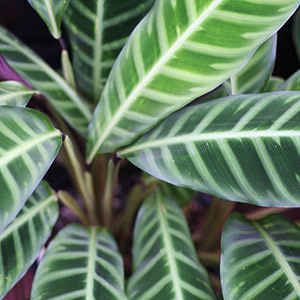Marantaceae

Calathea zebrina or Zebra plant is widely grown as an indoor plant.
It is a native of Brazil where it naturally grows in shade and requires a warm climate to thrive.
It is a good plant to grow as an indoor plant, as it loves filtered light and warmth.
It is said to be not toxic to cats and dogs so is popular with pet owners.
This is a low growing evergreen perennial grown mainly for its striking foliage, large velvety leaves are green with darker green stripes
A feature of the plant that is often overlooked is the underside of the foliage which are a purple color.
Over time the Zebra plant will form a clump, masses of attractive foliage and widely used in offices and commercial buildings where it thrives.
Although Calathea zebrina will flower, the flowers themselves are rather inconspicuous and are often pruned off so that the foliage remains the main attraction.
How to Grow Calathea zebrina
- Calathea zebrina is often grown indoors or in a shade house, hot direct sun will scorch the foliage. A humus rich moist well drained soil is best.
- A temperature range from 60F – 80F is best. It is also important to keep the Zebra Plant away from cold drafts, external doorways and similar.
- Light needs to be filtered, dappled shade, this is why the plant thrives indoors.
- Humidity is important and this can be achieved by sitting the pot on some pebbles in a saucer of water. This raises the pot above the water to mallow for good drainage while providing humidity as well. Off course you can also mist.
- Re-pot every 3 years into a free draining potting mix. Plants can also be divided at this time.
Common Problems
- Brown dried leaf edges.
Usually caused by low humidity. Try sitting the pot on a saucer of water filled with water. OR Mist spray once or twice a week. - Drooping Leaves
This can be caused by overwatering or by low temperatures. Check that the soil is not wet and soggy. Move to a warmer position.
Calathea Varieties
A number of Calathea species are garden worthy, and in fact much hybridization has taken place over the past 20 – 30 years.
So cultivars such as Calathea silhouette, pictured right and many others with different names are readily available for sale.
Species include :
- Calathea rufibarba – Also known as the ‘Furry Feather Calathea.
- Calathea lutea – Interestingly known as the ‘Havana Cigar’, large oval leaves on tall stems.
- Calathea Medallion
Propagation
Propagation is by digging and dividing established clumps.
Where to buy
Generally available for sale at nurseries from spring through to summer

